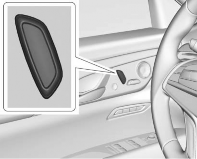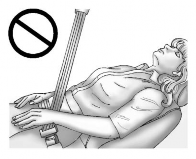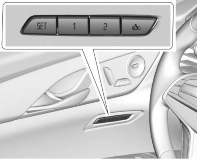
< Previous | Contents | Next >

Platinum Seat Shown, Base and Uplevel Seats Similar
To adjust:
. Tilt the top of the control rearward to recline.
. Tilt the top of the control forward to raise the seatback.

{ Warning
Sitting in a reclined position when the vehicle is in motion can be
dangerous. Even when buckled up, the seat belts cannot do their job.
The shoulder belt will not be
against your body. Instead, it will be in front of you. In a crash, you
could go into it, receiving neck or other injuries.
The lap belt could go up over your abdomen. The belt forces would be
there, not at your pelvic bones. This could cause serious internal
injuries.
For proper protection when the vehicle is in motion, have the
seatback upright. Then sit well back in the seat and wear the seat belt
properly.
![]()
![]()
SEATS AND RESTRAINTS 69

Do not have a seatback reclined if the vehicle is moving.

Memory Seats
70 SEATS AND RESTRAINTS
![]()
If equipped, memory seats allow two
drivers to store and recall their unique seat positions for driving the vehicle,
and a shared exit position for getting out of the vehicle. Other feature
positions may also be set, such as power mirrors and power steering
wheel. Memory positions are linked to RKE transmitter 1 or 2 for automatic memory recalls.
Before storing, adjust all available memory feature positions. Turn the
ignition on and then press and release SET; a beep will sound. Then
immediately press and hold 1, 2,
or B (Exit) on the driver door until
two beeps sound. To manually recall these positions, press and hold 1, 2, or B until the saved position is
reached.
The vehicle identifies the current
driver’s RKE transmitter number (1–
8). See Remote Keyless Entry (RKE)
System Operation 0 35. Only RKE
transmitters 1 and 2 can be used for automatic memory recalls. A Driver
Information Center (DIC) welcome message indicating the transmitter
number may display for the first few
![]()
ignition cycles following a transmitter change. For Auto Memory Recall to
work properly, save the positions to
the memory button (1 or 2) matching the RKE transmitter number displayed in the DIC welcome message. Carry
the linked RKE transmitter when entering the vehicle.
Vehicle Personalization Settings
. To have the Auto Memory Recall movement begin when the vehicle is started, select the Settings
menu, then Vehicle, then Comfort and Convenience, and then Auto Memory Recall. Select On or Off.
See “Auto Memory Recall” later in
this section.
. To begin Easy Exit Recall
movement when the ignition is
turned off and the driver door is opened, or when the ignition is
turned off with the driver door
already opened, select the Settings menu, then Vehicle, then Comfort and Convenience, and then Easy
Exit Options. Select On or Off. See
“Easy Exit Recall” later in this
section.
![]()
. See Vehicle Personalization 0 168
for additional setting information.
Identifying Driver Number
To identify the driver number:
1. Start the vehicle with the other key or RKE transmitter. The DIC should display the driver
number; 1 or 2. Turn the ignition off and remove the key or RKE
transmitter from the vehicle.
2. Start the vehicle with the initial key or RKE transmitter. The DIC should display the other driver
number not shown in step 1.
Saving Memory Positions
Read these instructions completely before saving memory positions.
To save preferred driving positions 1 and 2:
1. Turn the ignition on or to ACC/ ACCESSORY.
A DIC welcome message may be displayed indicating number 1 or 2 for memory recalls.
SEATS AND RESTRAINTS 71
![]()
2. Adjust all available memory
features to the desired driving position.
3. Press and release SET; a beep will sound.
4. Immediately press and hold the 1 or 2 memory button matching the above DIC welcome message until two beeps sound.
If too much time passes between releasing SET and pressing 1, the memory position will not be
saved and two beeps will not sound. Repeat steps 3 and 4.
1 or 2 corresponds to the driver number. See “Identifying Driver Number” in this section.
5. Repeat Steps 1–4 for a second driver using 1 or 2.
To save the position for B and easy exit features, repeat Steps 1–4 using
B. This stores the position for
getting out of the vehicle.
Save preferred memory feature
positions to both 1 and 2 if you are the only driver.
![]()
Manually Recalling Memory Positions
Press and hold 1, 2, or B to recall the previously stored memory
positions.
To stop manual recall movement,
release 1, 2, or B. Recall can also be
stopped by pressing a power seat, SET, power mirror, or power steering wheel control. The driver or passenger side
mirror must be selected.
Auto Memory Recall
If equipped with memory seat 1, 2 or
B buttons on the passenger door,
those positions must be recalled
manually. They will not be linked to an RKE transmitter.
The vehicle identifies the number of the current driver’s RKE transmitter
(1–8). See Remote Keyless Entry (RKE)
System Operation 0 35. If the RKE transmitter is 1 or 2, and Auto
Memory Recall is programmed on in vehicle personalization, the positions saved to the same memory button
number 1 or 2 are automatically
recalled when the ignition is turned on, or turned from OFF to ACC/
![]()
ACCESSORY. RKE transmitters 3–8 will not provide automatic memory recalls.
To turn Auto Memory Recall on or off, see "Vehicle Personalization Settings"
previously in this section and Vehicle Personalization 0 168.
The transmission must be in P (Park) to initiate Auto Memory Recall. Auto Memory Recall will complete if the
vehicle is shifted out of P (Park) prior to reaching the stored memory
position.
To stop Auto Memory Recall
movement, turn the ignition off or press any of the following memory controls:
. Power seat
. Memory SET, 1, 2, or B
. Power mirror, with the driver or passenger side mirror selected
. Power steering wheel
If the stored memory seat position
does not automatically recall or recalls to the wrong positions, the driver’s
RKE transmitter number (1 or 2) may not match the memory button